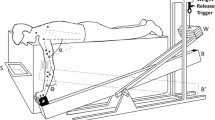Summary
When the hand is displaced from an equilibrium position, the muscles generate elastic forces to restore the original posture. In a previous study, Mussa-Ivaldi et al. (1985) have measured and characterized the field of elastic forces associated with hand posture in the horizontal plane. Hand stiffness which describes the relation between force and displacement vectors in the vicinity of equilibrium position was measured and graphically represented by an ellipse, characterized by its size, shape and orientation. The results indicated that the shape and orientation of the stiffness ellipse are strongly dependent on arm configuration. At any given hand position, however, the values of these parameters were found to remain invariant among subjects and over time. In this study we investigate the underlying causes for the observed spatial pattern of variation of the hand stiffness ellipse. Mathematically analyzing the relation between hand and joint stiffness matrices, we found that in order to produce the observed spatial variations of the stiffness ellipse, the shoulder stiffness must covary in the workspace with the stiffness component provided by the two-joint muscles. This condition was found to be satisfied by the measured joint stiffness components. Using anatomical data and considering the effects that muscle cross-sections and changes in muscle moment arms have on the joint stiffness matrix, we found that these anatomical factors are not sufficient to account for the observed pattern of variation of joint stiffness in the workspace. To examine whether the coupling between shoulder and two-joint stiffnesses results from the coactivation of muscles contributing to these stiffnesses, EMG signals were recorded from shoulder, elbow and two-joint muscles. Our results indicated that, while some muscle coactivation may indeed exist, it can be found for only some of the muscles and in only part of the workspace.
Similar content being viewed by others
References
An KN, Hui FC, Morrey RL, Linscheid RL, Chao EY (1981) Muscles across the elbow joint: a biomechanical analysis. J Biomech 14: 659–669
Amis AA, Dowson D, Wright V (1979) Muscle strength and muscolo-skeletal geometry of the upper limb. Eng Med 8: 41–48
Bizzi E, Accornero N, Chapple W, Hogan N (1984) Posture control and trajectory formation during arm movement. J Neurosci 4: 2738–2744
Cannon S, Zahalak GI (1982) The mechanical behavior of active human skeletal muscle in small oscillations. J Biomech 15: 111–121
Feldman AG (1966) Functional tuning of nervous system with control of movement or maintenance of a steady posture. II. Controllable parameters of the muscle. Biophysics 11: 565–78
Flash T, Mussa-Ivaldi FA (1984) Inferring movement and muscle synergies from multi-joint arm posture. Neurosciences Abstr 10: 635
Hasan Z, Enoka RM (1985) Isometric torque-angle relationship and movement related activity of human elbow flexors: implications for the equilibrium-point hypothesis. Exp Brain Res 59: 441–450
Hatze H (1980) Neuromusculoskeletal control system modeling: a critical survey of recent developments. IEEE Trans Auto Control AC-25: 375–385
Hoffer JA, Andreassen S (1981) Regulation of soleus muscle stiffness in premammillary cats: intrinsic and reflex components. J. Neurophysiol 45: 267–285
Hogan N (1985) The mechanics of multi-joint posture and movement. Biol Cybern 52: 315–331
Lacquaniti F, Soechting JF (1984) Behavior of the stretch reflex in a multi-jointed limb. Brain Res 311: 161–166
Houk JC, Rymer WZ (1981) Neural control of muscle length and tension. In: VB Brooks (ed) Handbook of physiology, Section 1. The nervous system, Vol 2. Motor control. American Physiological Society, Bethesda, MD, pp 257–323
Lacquaniti F, Soechting JF (1986) EMG responses to load perturbations of the upper limb: effect of dynamic coupling between shoulder and elbow motion. Exp Brain Res 61: 482–496
MacKay WA, Crammond DJ, Kwan HC, Murphy JT (1986) Measurements of human forearm viscoelasticity. J Biomech 19: 231–238
Morasso P (1981) Spatial control of arm movements. Exp Brain Res 42: 223–227
Mussa-Ivaldi FA, Hogan N, Bizzi E (1985) Neural, mechanical and geometric factors subserving arm posture in humans. J Neurosci 5: 2732–2743
Nichols TR, Houk JC (1976) Improvement in linearity and regulation of stiffness that results from actions of stretch reflex. J Neurophysiol 39: 119–142
Patriarco AG, Mann RW, Simon SR, Mansour JM (1981) An evaluation of the approaches of optimization models in the prediction of muscle forces during human gait. J Biomech 14: 513–525
Pedotti A, Krishnan VV, Stark L (1978) Optimization of muscle-force sequencing in human locomotion. Math Biosci 38: 57–76
Polit A, Bizzi E (1979) Characteristics of motor programs underlying arm movements in monkeys. J Neurophysiol 42: 183–194
Rack PMH, Westbury DR (1969) The effects of length and stimulus rate on tension in the isometric cat soleus muscle. J Physiol 204: 443–460
Rack PMH, Westbury DR (1974) The short range stiffness of active mammalian muscle and its effect on mechanical properties. J Physiol (Lond) 240: 331–350
Soechting JF, Lacquaniti F (1983) Modification of a trajectory of a pointing movement in response to a change in target location. J Neurophysiol 49: 548–564
van Zuylen EJ, Gielen CCAM, Denier van der Gon JJ (1988) Coordination and inhomogeneous activation of human arm muscles during isometric torques. J Neurophysiol 60: 1523–1548
Wood JE, Meek SG, Jacobsen SC (1989a) Quantitation of human shoulder anatomy for prosthetic arm control. I. Surface modelling. J Biomech. 22: 275–294
Wood JE, Meek SG, Jacobsen SC (1989a) Quantitation of human shoulder anatomy for prosthesis arm control. II. Anatomy matrices. J Biomech. 22: 309–326
Zahalak GI, Heyman SJ (1979) A quantitative evaluation of the frequency response characteristics of human skeletal muscle in vivo. J Biomech Eng 101: 38–37
Author information
Authors and Affiliations
Rights and permissions
About this article
Cite this article
Flash, T., Mussa-Ivaldi, F. Human arm stiffness characteristics during the maintenance of posture. Exp Brain Res 82, 315–326 (1990). https://doi.org/10.1007/BF00231251
Received:
Accepted:
Issue Date:
DOI: https://doi.org/10.1007/BF00231251




